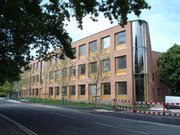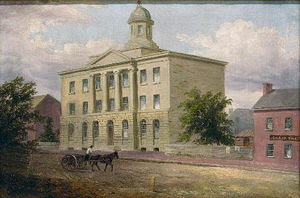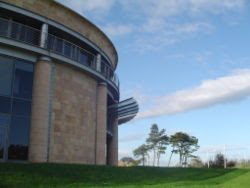The University of Southampton is a university situated in the city of Southampton, on the south coast of England. The university is a member of the Russell Group and of the Worldwide Universities Network.

In the most recent RAE assessment (2001), it has the only engineering faculty in the country to receive the highest rating (5*) across all disciplines. According to The Times Higher Education Supplement, the University has the second largest research income among British universities for the physical sciences and mathematics, and the third largest research income for engineering and technology. The University places great emphasis on inter-disciplinary cooperation and on collaboration with industry. This is most evident in the University's Business division.

History
The University of Southampton has its origin as the Hartley Institution which was formed in 1862 from a benefaction by Henry Robertson Hartley (1777-1850). Hartley was the son of a local wine merchant. On his death he left £103,000 to the Southampton Corporation on condition that it was invested "in such manner as might best promote the study and advancement of the sciences of Natural History, Astronomy, Antiquities, Classical and Oriental Literature in the town, such as by forming a Public Library, Botanic Gardens, Observatory, and collections of objects with the above sciences."
The city officials housed Hartley's books in a building in Southampton's High Street, in the city centre. The Hartley Institution was borne out of this, and became a university college in 1902. In 1919 it was renamed Hartley University College, and subsequently University College Southampton. Before 1952, the college's degrees were awarded by the University of London.

Having outgrown the High Street premises, the college was set to move to greenfield land near Highfield's Back Lane (now University Road). Although the new main building was formally opened on 20 June 1914, the outbreak of the First World War occurred before any lectures could take place there. The buildings were handed over by the college authorities for use as a military hospital. In order to cope with the volume of casualties, wooden huts were erected at the rear of the building. The college continued to use these after the war, eventually replacing the makeshift extension with brick buildings. With the continuing expansion, an academic bookshop was built on the site of Church Farm and the Students' Union complex and refectory were built on the site of Sir Sidney Kimber's brickyard.
In 1952, the Queen granted the University of Southampton a Royal Charter to award degrees in its own right. This conferred full university status and made Southampton independent of the University of London. Despite being one of the last of the "civic" universities, it grew rapidly and gained a reputation for a strong academic approach. It expanded rapidly during the 1960s, when a number of new plate glass universities were created; such as the University of East Anglia, University of Lancaster, University of Warwick, University of York and a number of others.
In 2005, a large fire destroyed part of the Mountbatten Building, holding optical fibre research laboratories (the world-renowned Optoelectronics Research Centre, ORC) and the microchip fabrication laboratories. It is estimated that the costs for rebuilding the centre and replacing the equipment will be around £50 million, making this what is believed to be the world's most destructive university fire.
Faculties

List of Faculties, Schools and Centres
Faculty of Engineering, Science and Mathematics
School of Chemistry
School of Civil Engineering and the Environment (includes the centre for Environmental Sciences)
School of Electronics and Computer Science (ECS)
School of Engineering Sciences (includes Aerospace Engineering, Mechanical Engineering and Ship Science)
School of Geography
School of Mathematics
School of Ocean and Earth Science (SOES)
School of Physics and Astronomy
Institute of Sound and Vibration Research (ISVR)
Optoelectronics Research Centre
Transportation Research Group (TRG)
National Oceanography Centre, Southampton (home of the School of Ocean and Earth Science) (NOCS)
Southampton E-Science Centre
Faculty of Law, Arts and Social Sciences
School of Social Sciences
School of Management - see below
School of Education
School of Law
School of Art (based at Winchester School of Art)
School of Humanities
Parkes Institute
Faculty of Medicine, Health and Life Sciences
School of Biological Sciences
School of Health Professions and Rehabilitation Sciences
School of Medicine
School of Nursing and Midwifery
School of Psychology
Health Care Innovation Unit
Southampton Statistical Sciences Research Institute
ESRC National Centre for Research Methods
School of Electronics and Computer Science
The School of Electronics and Computer Science, generally abbreviated "ECS", has been at the forefront of the Open Access movement.
The school is regarded as one of the best in the UK for both computer science and electronics, scoring 5th and 1st for the subjects respectively in the Guardian Unlimited University Guide 2008 and 5th and 2nd respectively by both the Times Online Good University Guide and the Good University Guide.
ECS was the first academic institution in the world to adopt a self-archiving mandate (2001) and since then much of its published research has been freely available on the Web. It created the first and most widely used archiving software (EPrints) which is used worldwide by 213 known archives and continues to be evolved and supported from the School .
The University of Southampton is planning to develop the UK’s first wholly integrated ‘professional campus’. The plans will see the transformation of the University’s Boldrewood campus.
Lloyd’s Register, an independent risk management organisation, will move its London marine operations to the Boldrewood campus.

The practice of corporations and business schools sharing resources and facilities is well established in some countries but this will be the first ‘professional campus’ in the UK. The Lloyd's Register Group will maintain its building in the City of London as the corporate office and governance of the Group will remain based there.

Web Science Research Initiative (WSRI)
The University of Southampton and the MIT recently announced the launch of a long-term research collaboration that aims to produce the fundamental scientific advances necessary to guide the future design and use of the World Wide Web.The Web Science Research Initiative (WSRI), is headed by Professor Tim Berners-Lee.
University of Southampton ranked 80th in the 2007 THES-QS World University Ranking
University of Southampton ranked 99th in the 2008 THES-QS World University Ranking
University of Southampton ranked 95th in the 2009 THES-QS World University Ranking
University of Southampton ranked 81st in the 2010 QS World University Ranking
University of Southampton ranked 75th in the 2011 QS World University Ranking













































